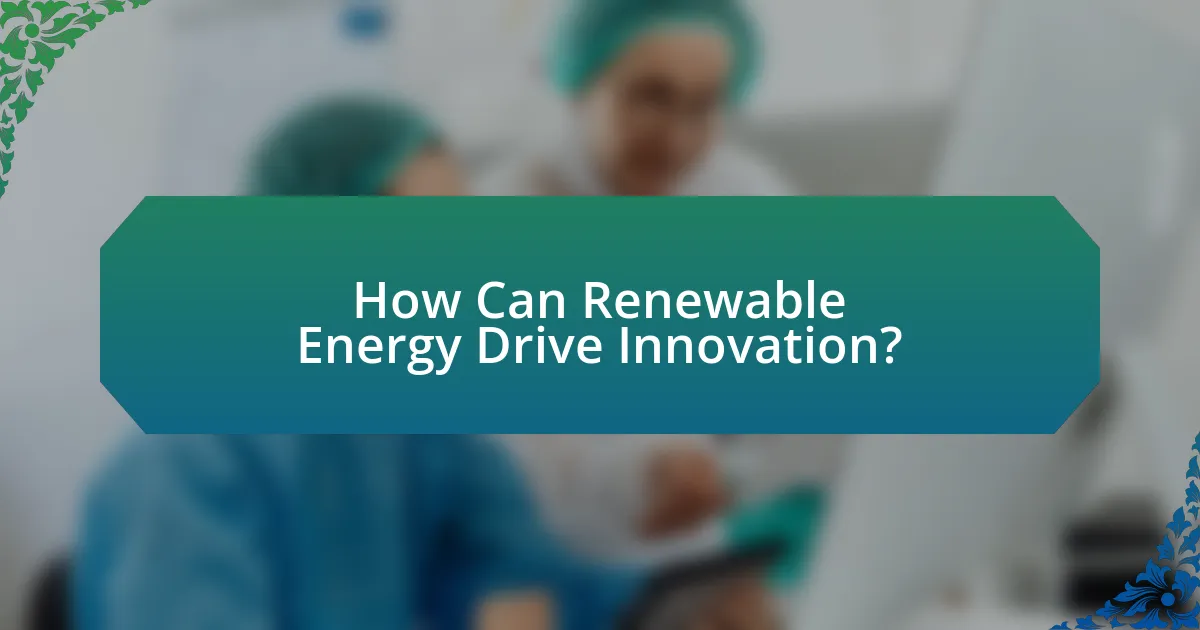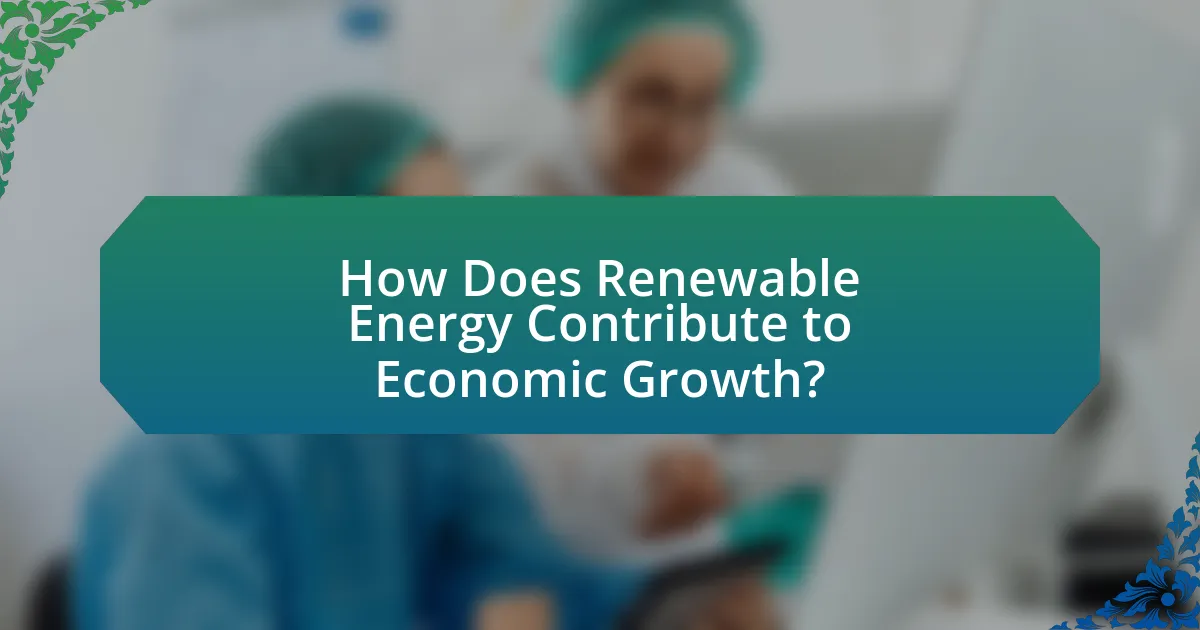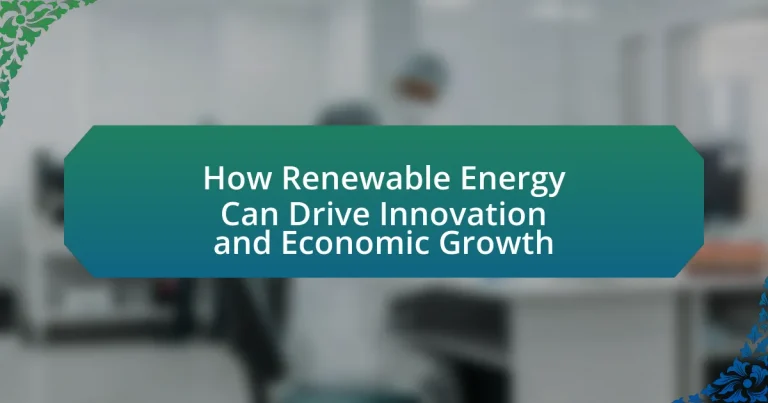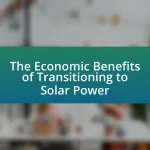Renewable energy serves as a catalyst for innovation and economic growth by driving advancements in technology, efficiency, and sustainable practices. The article explores how the transition to renewable sources, such as solar and wind, necessitates the development of new materials, energy storage solutions, and smart grid technologies, leading to significant market growth and job creation. Key innovations highlighted include improvements in solar photovoltaic efficiency, advancements in energy storage, and the role of wind energy in technological development. The economic benefits of renewable energy, including reduced energy costs and enhanced energy security, are also discussed, alongside the challenges and opportunities that exist within the sector. Overall, the article emphasizes the critical role of renewable energy in fostering a sustainable and competitive economy.

How Can Renewable Energy Drive Innovation?
Renewable energy can drive innovation by fostering advancements in technology, efficiency, and sustainable practices. The transition to renewable sources, such as solar and wind, necessitates the development of new materials, energy storage solutions, and smart grid technologies. For instance, the global solar energy market is projected to grow significantly, with a compound annual growth rate of over 20% from 2021 to 2028, indicating a strong demand for innovative solutions in this sector. Additionally, companies investing in renewable energy technologies often experience increased competitiveness and market differentiation, as seen in the rise of electric vehicles and energy-efficient appliances. This innovation not only enhances energy production but also contributes to economic growth by creating jobs and stimulating investment in research and development.
What are the key innovations emerging from renewable energy technologies?
Key innovations emerging from renewable energy technologies include advancements in solar photovoltaic efficiency, energy storage solutions, and smart grid technologies. Solar photovoltaic systems have seen efficiency improvements, with some technologies exceeding 25% efficiency, enhancing energy capture and reducing costs. Energy storage innovations, particularly in lithium-ion and solid-state batteries, have significantly increased capacity and reduced charging times, enabling better integration of intermittent renewable sources. Smart grid technologies facilitate real-time energy management and distribution, optimizing the use of renewable resources and improving grid resilience. These innovations collectively contribute to a more sustainable energy landscape and drive economic growth by creating jobs and reducing reliance on fossil fuels.
How do advancements in solar energy contribute to innovation?
Advancements in solar energy contribute to innovation by driving technological improvements and creating new market opportunities. For instance, the development of more efficient photovoltaic cells, such as perovskite solar cells, has increased energy conversion rates significantly, with some achieving over 25% efficiency. This efficiency boost not only enhances energy output but also reduces costs, making solar energy more accessible. Furthermore, innovations in energy storage technologies, like lithium-ion batteries, have improved the reliability of solar energy systems, enabling better integration into the grid. According to the International Energy Agency, solar power capacity has grown exponentially, reaching over 1,000 gigawatts globally by 2020, which underscores its role in fostering economic growth and job creation in the renewable energy sector.
What role does wind energy play in technological development?
Wind energy significantly contributes to technological development by driving advancements in turbine design, energy storage solutions, and grid integration technologies. The evolution of wind turbine technology, such as the development of larger and more efficient blades, has increased energy capture and reduced costs, exemplified by the fact that the cost of onshore wind energy has fallen by 70% since 2009, according to the International Renewable Energy Agency. Furthermore, innovations in energy storage, such as battery systems that complement wind energy generation, enhance reliability and efficiency, facilitating a more stable energy supply. Additionally, advancements in smart grid technologies enable better integration of wind energy into existing power systems, optimizing energy distribution and consumption. These developments not only enhance the efficiency of wind energy but also stimulate economic growth through job creation in manufacturing, installation, and maintenance sectors.
Why is innovation in renewable energy crucial for the economy?
Innovation in renewable energy is crucial for the economy because it drives job creation, enhances energy security, and promotes sustainable growth. The renewable energy sector has been a significant source of employment, with over 3 million jobs created globally in solar and wind industries as of 2021, according to the International Renewable Energy Agency. Additionally, innovation leads to cost reductions in energy production, making renewable sources more competitive against fossil fuels. For instance, the cost of solar photovoltaic systems has dropped by about 89% since 2000, as reported by the International Energy Agency. This economic shift not only reduces dependence on imported fuels but also fosters technological advancements that can lead to new markets and economic opportunities.
How does renewable energy innovation lead to job creation?
Renewable energy innovation leads to job creation by fostering new industries and enhancing existing ones. As technologies such as solar, wind, and bioenergy develop, they require skilled labor for manufacturing, installation, and maintenance. For instance, the U.S. solar industry employed over 250,000 workers in 2019, reflecting a growth rate of 167% since 2010, according to the Solar Foundation’s National Solar Jobs Census. This trend indicates that advancements in renewable technologies not only create direct employment opportunities but also stimulate ancillary jobs in sectors like manufacturing, logistics, and services, thereby contributing to overall economic growth.
What impact does renewable energy innovation have on global competitiveness?
Renewable energy innovation significantly enhances global competitiveness by fostering technological advancements and reducing energy costs. Countries that invest in renewable technologies, such as solar and wind, often experience increased efficiency and lower dependency on fossil fuels, which can lead to economic growth. For instance, the International Renewable Energy Agency reported that the renewable energy sector employed over 11 million people globally in 2018, demonstrating its capacity to create jobs and stimulate economies. Furthermore, nations leading in renewable energy innovation, like Germany and China, have gained substantial market shares in the global energy market, showcasing how innovation can translate into economic power and influence.

How Does Renewable Energy Contribute to Economic Growth?
Renewable energy contributes to economic growth by creating jobs, stimulating technological innovation, and reducing energy costs. The renewable energy sector has generated millions of jobs globally; for instance, the International Renewable Energy Agency reported that the sector employed over 11 million people in 2018, with significant growth projected in the coming years. Additionally, investments in renewable technologies drive innovation, leading to advancements in efficiency and cost-effectiveness, which further enhance economic productivity. Furthermore, renewable energy sources often lead to lower energy costs for consumers and businesses, as they reduce reliance on imported fuels and mitigate price volatility. This combination of job creation, innovation, and cost savings illustrates how renewable energy serves as a catalyst for economic growth.
What are the economic benefits of transitioning to renewable energy?
Transitioning to renewable energy generates significant economic benefits, including job creation, reduced energy costs, and enhanced energy security. The renewable energy sector has been a major source of employment, with over 3 million jobs created in the United States alone by 2021, according to the U.S. Department of Energy. Additionally, renewable energy sources like solar and wind have lower operational costs compared to fossil fuels, leading to decreased energy prices for consumers and businesses. Furthermore, investing in renewable energy enhances energy security by reducing dependence on imported fuels, which can be subject to volatile prices and geopolitical tensions. These factors collectively contribute to a more resilient and sustainable economy.
How does renewable energy reduce energy costs for consumers?
Renewable energy reduces energy costs for consumers primarily by decreasing reliance on fossil fuels, which are subject to volatile prices. As renewable energy sources like solar and wind become more prevalent, their operational costs decline due to technological advancements and economies of scale. For instance, the International Renewable Energy Agency reported that the cost of solar photovoltaic (PV) systems fell by 82% between 2010 and 2019, making solar energy increasingly affordable for consumers. Additionally, renewable energy systems often have lower maintenance costs compared to traditional energy sources, further contributing to reduced overall energy expenses for households.
What is the impact of renewable energy on local economies?
Renewable energy positively impacts local economies by creating jobs, increasing local investment, and enhancing energy independence. For instance, the solar and wind industries have generated over 3 million jobs in the United States alone as of 2021, according to the U.S. Department of Energy. Additionally, local investments in renewable energy projects stimulate economic growth by attracting businesses and fostering innovation, as seen in regions that have embraced clean energy initiatives. Furthermore, renewable energy reduces reliance on imported fuels, allowing local economies to retain more capital within their communities, thereby promoting sustainable economic development.
How can governments support economic growth through renewable energy?
Governments can support economic growth through renewable energy by implementing policies that incentivize investment in clean technologies and infrastructure. For instance, offering tax credits and subsidies for renewable energy projects encourages businesses to invest in solar, wind, and other sustainable energy sources. According to the International Renewable Energy Agency, the renewable energy sector employed over 11 million people globally in 2018, demonstrating its potential to create jobs and stimulate economic activity. Additionally, governments can facilitate research and development funding, which fosters innovation in renewable technologies, further driving economic growth.
What policies are effective in promoting renewable energy investments?
Effective policies for promoting renewable energy investments include feed-in tariffs, tax incentives, and renewable portfolio standards. Feed-in tariffs guarantee fixed payments for energy producers, ensuring a stable revenue stream that encourages investment. For example, Germany’s feed-in tariff policy has significantly increased solar energy capacity, leading to a 50% reduction in costs over a decade. Tax incentives, such as the Investment Tax Credit in the United States, provide financial benefits that lower the upfront costs for renewable energy projects, resulting in a 70% increase in solar installations since its implementation. Renewable portfolio standards require utilities to obtain a certain percentage of their energy from renewable sources, driving demand and investment in clean energy technologies. States like California have successfully implemented these standards, leading to a substantial increase in renewable energy generation and job creation in the sector.
How do subsidies and incentives influence renewable energy adoption?
Subsidies and incentives significantly enhance renewable energy adoption by reducing the financial barriers associated with initial investments. These financial supports, such as tax credits and grants, lower the cost of renewable technologies, making them more attractive to consumers and businesses. For instance, the U.S. federal solar investment tax credit allows homeowners to deduct a percentage of the cost of installing solar energy systems from their federal taxes, which has led to a substantial increase in solar installations—over 97% growth from 2010 to 2020, according to the Solar Energy Industries Association. This financial encouragement not only accelerates the deployment of renewable energy technologies but also stimulates job creation and economic growth within the sector.

What Challenges and Opportunities Exist in the Renewable Energy Sector?
The renewable energy sector faces significant challenges and opportunities that impact its growth and innovation potential. Key challenges include high initial capital costs, technological limitations, and regulatory hurdles that can impede project development. For instance, the International Renewable Energy Agency reported that the upfront investment for solar and wind projects can be substantial, often requiring government incentives or private financing to become viable.
Conversely, opportunities in the sector are driven by advancements in technology, decreasing costs of renewable energy sources, and increasing global demand for clean energy solutions. The cost of solar photovoltaic systems has dropped by over 80% since 2010, according to the International Energy Agency, making solar energy more accessible and competitive with fossil fuels. Additionally, the transition to renewable energy presents economic growth opportunities, such as job creation in manufacturing, installation, and maintenance of renewable energy systems, with the U.S. Bureau of Labor Statistics projecting that jobs in the solar and wind industries will grow significantly in the coming years.
What are the main challenges facing renewable energy innovation?
The main challenges facing renewable energy innovation include high initial costs, technological limitations, regulatory barriers, and market competition. High initial costs hinder investment in renewable technologies, as seen in the solar and wind sectors where upfront capital can be substantial. Technological limitations, such as energy storage and efficiency issues, restrict the scalability of renewable solutions; for instance, current battery technologies struggle to meet the demands of large-scale energy storage. Regulatory barriers, including inconsistent policies and lack of incentives, create uncertainty for investors and developers, impacting project viability. Lastly, market competition from established fossil fuel industries often leads to price undercutting, making it difficult for renewable energy sources to compete effectively. These challenges collectively impede the growth and adoption of renewable energy innovations.
How do regulatory barriers affect renewable energy development?
Regulatory barriers significantly hinder renewable energy development by imposing restrictions that limit investment and innovation. These barriers can include complex permitting processes, inconsistent policies, and lack of incentives, which create uncertainty for investors and developers. For instance, a report by the International Renewable Energy Agency (IRENA) highlights that countries with streamlined regulatory frameworks see a 30% increase in renewable energy investments compared to those with stringent regulations. This demonstrates that easing regulatory constraints can facilitate faster deployment of renewable technologies, ultimately driving economic growth and innovation in the sector.
What technological hurdles must be overcome for growth?
The technological hurdles that must be overcome for growth in renewable energy include energy storage, grid integration, and efficiency improvements. Energy storage technologies, such as advanced batteries, need to be developed to store excess energy generated from renewable sources, as current solutions are often costly and limited in capacity. Grid integration challenges arise from the need to adapt existing infrastructure to accommodate variable energy sources like solar and wind, which require smart grid technologies for effective management. Efficiency improvements in renewable energy technologies, such as solar panels and wind turbines, are essential to maximize energy output and reduce costs, as evidenced by the fact that the efficiency of solar panels has increased from around 15% in the early 2000s to over 22% today. Addressing these hurdles is critical for the widespread adoption and economic growth driven by renewable energy.
What opportunities can arise from overcoming these challenges?
Overcoming challenges in renewable energy can lead to significant opportunities such as technological advancements, job creation, and enhanced energy security. For instance, the transition to renewable energy sources has spurred innovation in energy storage technologies, which can improve efficiency and reliability. According to a report by the International Renewable Energy Agency (IRENA), the renewable energy sector employed 11.5 million people globally in 2018, and this number is projected to grow as investments in clean energy increase. Additionally, reducing reliance on fossil fuels enhances energy security by diversifying energy sources and stabilizing prices, which can foster economic resilience.
How can collaboration between sectors enhance renewable energy innovation?
Collaboration between sectors can enhance renewable energy innovation by facilitating the sharing of resources, expertise, and technology. When public and private sectors, along with academia, work together, they can leverage diverse perspectives and capabilities to accelerate research and development. For instance, partnerships between energy companies and technology firms have led to advancements in solar panel efficiency and energy storage solutions, as seen in the collaboration between Tesla and Panasonic, which resulted in significant improvements in battery technology. Additionally, cross-sector collaboration can lead to the establishment of supportive policies and funding mechanisms, exemplified by initiatives like the Clean Energy Innovation Fund in the United States, which promotes joint efforts to drive innovation in renewable energy.
What role do startups play in driving renewable energy advancements?
Startups play a crucial role in driving renewable energy advancements by fostering innovation and developing new technologies that enhance energy efficiency and sustainability. These companies often operate with agility, allowing them to quickly adapt to market needs and explore novel solutions, such as solar energy innovations, energy storage systems, and smart grid technologies. For instance, according to a report by the International Renewable Energy Agency (IRENA), startups have been instrumental in reducing the cost of solar energy by over 80% since 2010 through technological advancements and competitive pricing strategies. This dynamic environment not only accelerates the deployment of renewable energy solutions but also attracts investment, creating economic growth and job opportunities in the sector.
What are the best practices for leveraging renewable energy for economic growth?
The best practices for leveraging renewable energy for economic growth include investing in technology innovation, creating supportive policies, and fostering public-private partnerships. Investing in technology innovation, such as solar and wind energy advancements, can lead to job creation and increased efficiency; for instance, the solar industry employed over 250,000 workers in the U.S. in 2020, reflecting significant economic impact. Creating supportive policies, like tax incentives and renewable energy mandates, encourages businesses to adopt clean energy solutions, as seen in countries like Germany, which has successfully transitioned to a renewable energy economy. Additionally, fostering public-private partnerships can enhance resource allocation and drive investment in renewable projects, exemplified by the collaboration between governments and companies in the development of offshore wind farms, which are projected to generate substantial economic benefits.




